Firstly, just be aware that Qt already uses the concept of views and models but that's not actually what you're after. In short the Qt MCV concept is a way to automatically link a widget (e.g. a QListView) to a data source (e.g. a QStringListModel) so that changes to the data in the model automagically appear in the widget and vice versa. This is a (very) useful feature but it's a different thing to an application scale MVC design pattern. The two concepts can be used together of course and that does offer some obvious shortcuts. Application scale MVC design however must be manually programmed.
Here's an example MVC application that has a single view, controller, and model. The view has 3 widgets that each independently listen for and react to changes to data in the model. The spin box and button can both manipulate data in the model via the controller.

The file structure is arranged like this:
project/
mvc_app.py # main application with App class
mvc_app_rc.py # auto-generated resources file (using pyrcc.exe or equivalent)
controllers/
main_ctrl.py # main controller with MainController class
other_ctrl.py
model/
model.py # model with Model class
resources/
mvc_app.qrc # Qt resources file
main_view.ui # Qt designer files
other_view.ui
img/
icon.png
views/
main_view.py # main view with MainView class
main_view_ui.py # auto-generated ui file (using pyuic.exe or equivalent)
other_view.py
other_view_ui.py
Application
mvc_app.py would be responsible for instantiating each of the view, controllers, and model(s) and passing references between them. This can be quite minimal:
import sys
from PyQt5.QtWidgets import QApplication
from model.model import Model
from controllers.main_ctrl import MainController
from views.main_view import MainView
class App(QApplication):
def __init__(self, sys_argv):
super(App, self).__init__(sys_argv)
self.model = Model()
self.main_controller = MainController(self.model)
self.main_view = MainView(self.model, self.main_controller)
self.main_view.show()
if __name__ == '__main__':
app = App(sys.argv)
sys.exit(app.exec_())
Views
Use Qt designer to create the .ui layout files to the extent that you assign variables names to widgets and adjust their basic properties. Don't bother adding signals or slots as it's generally easier just to connect them to functions from within the view class.
The .ui layout files are converted to .py layout files when processed with pyuic or pyside-uic. The .py view files can then import the relevant auto-generated classes from the .py layout files.
The view class(es) should contain the minimal code required to connect to the signals coming from the widgets in your layout. View events can call and pass basic information to a method in the view class and onto a method in a controller class, where any logic should be. It would look something like:
from PyQt5.QtWidgets import QMainWindow
from PyQt5.QtCore import pyqtSlot
from views.main_view_ui import Ui_MainWindow
class MainView(QMainWindow):
def __init__(self, model, main_controller):
super().__init__()
self._model = model
self._main_controller = main_controller
self._ui = Ui_MainWindow()
self._ui.setupUi(self)
# connect widgets to controller
self._ui.spinBox_amount.valueChanged.connect(self._main_controller.change_amount)
self._ui.pushButton_reset.clicked.connect(lambda: self._main_controller.change_amount(0))
# listen for model event signals
self._model.amount_changed.connect(self.on_amount_changed)
self._model.even_odd_changed.connect(self.on_even_odd_changed)
self._model.enable_reset_changed.connect(self.on_enable_reset_changed)
# set a default value
self._main_controller.change_amount(42)
@pyqtSlot(int)
def on_amount_changed(self, value):
self._ui.spinBox_amount.setValue(value)
@pyqtSlot(str)
def on_even_odd_changed(self, value):
self._ui.label_even_odd.setText(value)
@pyqtSlot(bool)
def on_enable_reset_changed(self, value):
self._ui.pushButton_reset.setEnabled(value)
The view doesn't do much apart from link widget events to the relevant controller function, and listen for changes in the model, which are emitted as Qt signals.
Controllers
The controller class(es) perform any logic and then sets data in the model. An example:
from PyQt5.QtCore import QObject, pyqtSlot
class MainController(QObject):
def __init__(self, model):
super().__init__()
self._model = model
@pyqtSlot(int)
def change_amount(self, value):
self._model.amount = value
# calculate even or odd
self._model.even_odd = 'odd' if value % 2 else 'even'
# calculate button enabled state
self._model.enable_reset = True if value else False
The change_amount function takes the new value from the widget, performs logic, and sets attributes on the model.
Model
The model class stores program data and state and some minimal logic for announcing changes to this data. This model shouldn't be confused with the Qt model (see http://qt-project.org/doc/qt-4.8/model-view-programming.html) as it's not really the same thing.
The model might look like:
from PyQt5.QtCore import QObject, pyqtSignal
class Model(QObject):
amount_changed = pyqtSignal(int)
even_odd_changed = pyqtSignal(str)
enable_reset_changed = pyqtSignal(bool)
@property
def amount(self):
return self._amount
@amount.setter
def amount(self, value):
self._amount = value
self.amount_changed.emit(value)
@property
def even_odd(self):
return self._even_odd
@even_odd.setter
def even_odd(self, value):
self._even_odd = value
self.even_odd_changed.emit(value)
@property
def enable_reset(self):
return self._enable_reset
@enable_reset.setter
def enable_reset(self, value):
self._enable_reset = value
self.enable_reset_changed.emit(value)
def __init__(self):
super().__init__()
self._amount = 0
self._even_odd = ''
self._enable_reset = False
Writes to the model automatically emit signals to any listening views via code in the setter decorated functions. Alternatively the controller could manually trigger the signal whenever it decides.
In the case where Qt model types (e.g. QStringListModel) have been connected with a widget then the view containing that widget does not need to be updated at all; this happens automatically via the Qt framework.
UI source file
For completion, the example main_view.ui file is included here:
<?xml version="1.0" encoding="UTF-8"?>
<ui version="4.0">
<class>MainWindow</class>
<widget class="QMainWindow" name="MainWindow">
<property name="geometry">
<rect>
<x>0</x>
<y>0</y>
<width>93</width>
<height>86</height>
</rect>
</property>
<widget class="QWidget" name="centralwidget">
<layout class="QVBoxLayout">
<item>
<widget class="QSpinBox" name="spinBox_amount"/>
</item>
<item>
<widget class="QLabel" name="label_even_odd"/>
</item>
<item>
<widget class="QPushButton" name="pushButton_reset">
<property name="enabled">
<bool>false</bool>
</property>
</widget>
</item>
</layout>
</widget>
</widget>
<resources/>
<connections/>
</ui>
It is converted to main_view_ui.py by calling:
pyuic5 main_view.ui -o ..\views\main_view_ui.py
The resource file mvc_app.qrc is converted to mvc_app_rc.py by calling:
pyrcc5 mvc_app.qrc -o ..\mvc_app_rc.py
Interesting links
Why Qt is misusing model/view terminology?
